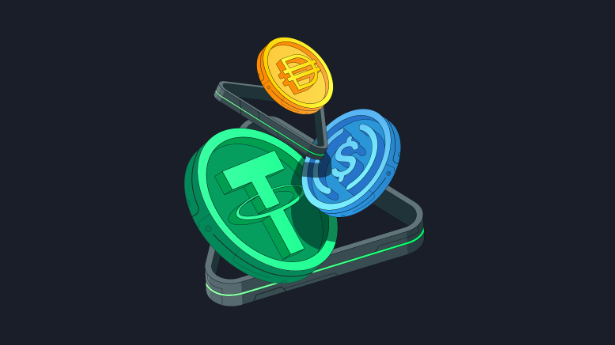Stablecoins have emerged as a crucial component within the volatile landscape of cryptocurrency markets. These digital assets, pegged to stable assets like fiat currencies or commodities, provide a reliable bridge between traditional financial systems and the rapidly evolving realm of cryptocurrencies. As the cryptonewzhub.com market continues to experience fluctuations, stablecoins offer a haven of stability for investors and users alike. In this article, we delve into the pivotal role stablecoins play in fostering stability amidst market turbulence.
Understanding Stablecoins
Stablecoins, as the name suggests, are cryptocurrencies designed to maintain a stable value, typically by pegging their worth to that of fiat currencies like the US dollar or other assets such as gold or other cryptocurrencies. This stability is achieved through various mechanisms, including collateralization, algorithmic methods, or a combination of both. Unlike volatile cryptocurrencies like Bitcoin or Ethereum, stablecoins aim to minimize price fluctuations, making them more suitable for everyday transactions and as a store of value.
Types of Stablecoins
There are several types of stablecoins, each with its unique mechanism for maintaining stability:
1. Fiat-Collateralized Stablecoins
Fiat-collateralized stablecoins are backed by reserves of fiat currency, such as the US dollar, held in a bank account. For every unit of stablecoin issued, there is an equivalent amount of fiat currency held in reserve. Examples of fiat-collateralized stablecoins include Tether (USDT), USD Coin (USDC), and TrueUSD (TUSD).
2. Crypto-Collateralized Stablecoins
Crypto-collateralized stablecoins are backed by a reserve of other cryptocurrencies, which are used as collateral to maintain price stability. These stablecoins often rely on over-collateralization, where the value of the collateral exceeds that of the stablecoin issued. Dai, created by MakerDAO, is a prominent example of a crypto-collateralized stablecoin.
3. Algorithmic Stablecoins
Algorithmic stablecoins use algorithms to dynamically adjust the supply of tokens in response to changes in demand, aiming to stabilize their value. These stablecoins do not rely on collateral but instead employ mechanisms such as algorithmic trading or smart contracts to maintain price stability. Examples include Terra (LUNA) and Ampleforth (AMPL).
The Importance of Stablecoins in a Volatile Market
In a volatile crypto market characterized by rapid price fluctuations, stablecoins serve several crucial purposes:
1. Hedging Against Volatility
Stablecoins provide a safe haven for investors looking to hedge against the extreme volatility inherent in many cryptocurrencies. By holding stablecoins, investors can swiftly move funds out of volatile assets during periods of uncertainty, preserving capital and reducing the risk of significant losses.
2. Facilitating Seamless Transactions
The stability of stablecoins makes them an ideal medium of exchange for everyday transactions within the crypto ecosystem. Whether it’s purchasing goods and services or transferring value across borders, stablecoins offer a reliable means of conducting transactions without the fear of price volatility impacting the transaction’s value.
3. Price Stability in Decentralized Finance (DeFi)
Decentralized Finance (DeFi) platforms leverage stablecoins to provide users with access to various financial services, such as lending, borrowing, and trading, without the need for traditional financial intermediaries. Stablecoins serve as the primary medium of exchange within DeFi protocols, offering users stability while engaging in complex financial transactions.
Challenges and Considerations
While stablecoins offer numerous benefits, they also face several challenges and considerations:
1. Regulatory Scrutiny
Stablecoins, particularly those pegged to fiat currencies, have attracted increased regulatory scrutiny from authorities worldwide. Concerns regarding compliance, transparency, and potential systemic risks have prompted regulatory bodies to examine stablecoin issuers and their operations more closely.
2. Counterparty Risk
Fiat-collateralized stablecoins are susceptible to counterparty risk, as they rely on third-party custodians to hold the reserves backing the stablecoin. Any failure or malfeasance by these custodians could jeopardize the stability and redeemability of the stablecoin.
3. Centralization Concerns
Some stablecoins, especially those issued by centralized entities, raise concerns about centralization. Centralized stablecoin issuers have control over the issuance and redemption of tokens, leading to questions about transparency, censorship resistance, and overall decentralization within the crypto ecosystem.
Conclusion
stablecoins play a pivotal role in providing stability within the volatile landscape of cryptocurrency markets. Whether it’s mitigating price volatility, facilitating seamless transactions, or powering decentralized financial applications, stablecoins have emerged as indispensable assets in the crypto ecosystem. However, challenges such as regulatory scrutiny, counterparty risk, and centralization concerns underscore the need for ongoing innovation and regulatory clarity to ensure the continued growth and adoption of stablecoins in the years to come. As the crypto market evolves, stablecoins are poised to remain a cornerstone of stability amidst uncertainty.
Iva Ort is an ingenious wordsmith and captivating blogger whose tales leap off the screen and into your imagination. With a pen as her wand, she weaves enchanting stories and insightful articles, leaving readers spellbound and craving more.
